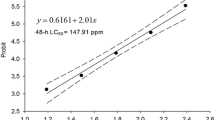Abstract.
The feeding response of juvenile amphipod Gammarus pulex (L.) was investigated following exposure to freshwater pollutants. The method employed is nondestructive, provides a rapid indication of the status of groups of individuals, and is based on a time-response analysis of the consumption of the eggs of Artemia salina and the determination of median feeding times or FT50s. The feeding activity of juvenile G. pulex was found to be a sensitive response criterion for use in assessing the sublethal toxicity of copper, lindane, and 3,4-dichloroaniline (3,4-DCA). Reductions in gammarid feeding activity were identified following 96 hours exposure at 12.1 μg/L copper or 8.4 μg/L lindane and 240 hours exposure at 918 μg/L 3,4-DCA. However, a significant increase was observed in the feeding rate of gammarids that had been exposed for 240 h at 0.09 μg/L lindane in comparison with control values. The increase in feeding rate may be interpreted as a possible stimulatory effect associated with the toxicant action of lindane. Increases in gammarid feeding activity were not determined during the experiments conducted with either copper or 3,4-DCA. A sustained reduction in G. pulex feeding rates may cause growth inhibition and impaired reproduction which have previously been identified as sublethal responses of other freshwater organisms exposed to comparable concentrations of lindane, 3,4-DCA, or copper. The feeding bioassay was also used as a tool in an investigation of species interactions in toxicant systems. The feeding responses of G. pulex, which had been maintained in the presence of Asellus aquaticus (as interacting pairs) and exposed to a range of concentrations of lindane or 3,4-DCA, were recorded and compared. The findings illustrate the complex nature of test systems that integrate the stresses of toxicant and competition. In the lindane test system a reduction in gammarid feeding activity was observed following a 96-h exposure with A. aquaticus at 3.8 and 6.0 μg/L lindane (mean measured concentrations). After a 240-h exposure period a decrease in feeding rate was recorded only for gammarids that had been exposed to 6.5 μg/L lindane, however exposure to very low concentrations of lindane (0.1 and 0.9 μg/L) resulted in a significant increase in gammarid feeding activity. In the experiment conducted with 3,4-DCA the calculation of median feeding times or FT50s of gammarids that had been exposed for 96 and 240 h in the toxicant treatment groups with A. aquaticus was largely precluded (in most groups less than 50% of the A. salina eggs were eaten). However, control group FT50 values were determined on each occasion the bioassay was performed, indicating that a substantial reduction in gammarid feeding activity had occurred in the majority of the 3,4-DCA treatment groups.
Similar content being viewed by others
Author information
Authors and Affiliations
Additional information
Received: 3 April 1997/Accepted: 6 August 1997
Rights and permissions
About this article
Cite this article
Blockwell, S., Taylor, E., Jones, I. et al. The Influence of Fresh Water Pollutants and Interaction with Asellus aquaticus (L.) on the Feeding Activity of Gammarus pulex (L.). Arch Environ Contam Toxicol 34, 41–47 (1998). https://doi.org/10.1007/s002449900284
Published:
Issue Date:
DOI: https://doi.org/10.1007/s002449900284




